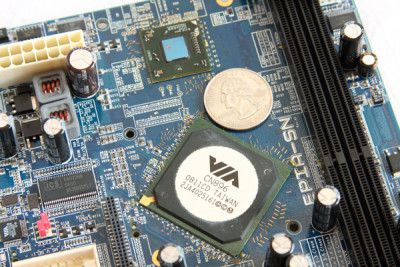From our front-page news:
It's not often that we report on CPU competition between Intel and someone other than AMD, but that happens now. Our friends at PC Perspective have two platforms on hand, Intel's Atom and VIA's Nano, and pits them against each other to see which one comes out on top. The results might just surprise you.
Performance aside, the biggest issue here lays with Intel's implementation of Atom. They don't offer an open platform, and restrict what components can be used. It was their decision to omit PCI-Express, which means consumers are stuck with old-school PCI GPUs. VIA, on the other hand, welcome PCI-Express cards. That's the kind of support we need, and Intel needs to seriously re-evaluate their position on keeping a locked platform, especially after these initial Nano results.
In their tests, PC Per found the Nano to out-perform Atom in almost all regards. Granted, the chip was operating at 1.8GHz, compared to Atom's 1.6GHz, but some differences seen go beyond the scope of such a minor increase. Atom wasn't a total loss by a longshot though, as it was exceptional where power consumption was concerned. In the end, it comes down to a classic trade-off, power consumption or raw performance. If anything, it's really good to see VIA as serious competition in this market now. To come out of nowhere (relatively) and immediately compete with Intel's latest product, is a huge accomplishment.
<table align="center" border="0"> <tbody> <tr> <td>

Credit: PC Perspective</td> </tr> </tbody> </table>
For an incredibly inexpensive and low power part, the VIA Nano L2100 CPU was very impressive from a performance perspective. Using just 20 watts or so of power at load the Isaiah architecture running at 1.8 GHz could handle our media encoding, our PCMark05 general purpose tests and even a little gaming.
Source: PC Perspective
Performance aside, the biggest issue here lays with Intel's implementation of Atom. They don't offer an open platform, and restrict what components can be used. It was their decision to omit PCI-Express, which means consumers are stuck with old-school PCI GPUs. VIA, on the other hand, welcome PCI-Express cards. That's the kind of support we need, and Intel needs to seriously re-evaluate their position on keeping a locked platform, especially after these initial Nano results.
In their tests, PC Per found the Nano to out-perform Atom in almost all regards. Granted, the chip was operating at 1.8GHz, compared to Atom's 1.6GHz, but some differences seen go beyond the scope of such a minor increase. Atom wasn't a total loss by a longshot though, as it was exceptional where power consumption was concerned. In the end, it comes down to a classic trade-off, power consumption or raw performance. If anything, it's really good to see VIA as serious competition in this market now. To come out of nowhere (relatively) and immediately compete with Intel's latest product, is a huge accomplishment.
<table align="center" border="0"> <tbody> <tr> <td>

Credit: PC Perspective</td> </tr> </tbody> </table>
For an incredibly inexpensive and low power part, the VIA Nano L2100 CPU was very impressive from a performance perspective. Using just 20 watts or so of power at load the Isaiah architecture running at 1.8 GHz could handle our media encoding, our PCMark05 general purpose tests and even a little gaming.
Source: PC Perspective
